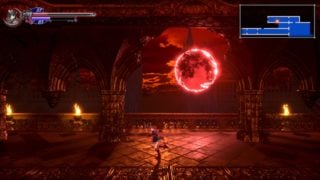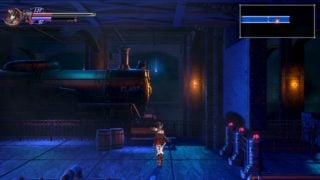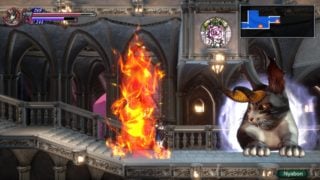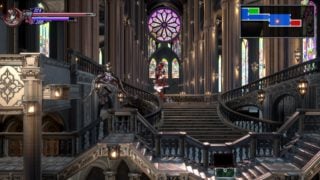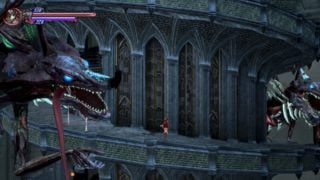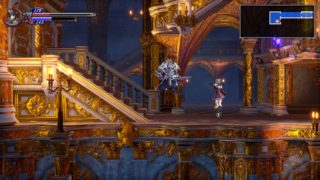Review: Bloodstained is a Gothic oddball of an action RPG
Koji Igarashi delivers the revamp Castlevania fans asked for
- Game Director
- Shūtarō Iida
- Key Credits
- Koji Igarashi (Producer), Michiru Yamane (Composer), Erica Lindbeck (Miriam Actor)

How to explain Artplay’s spiritual Castlevania reboot Bloodstained: Ritual of the Night to somebody not steeped in three decades’ worth of Castlevania games? Let’s take a cue from the title and say that playing it is like being trapped in a gigantic stained-glass window, crafted by the Devil himself.
Each pane is a room – a decadent little picture within the picture, criss-crossed by platforms and stairways – and every room has its demons, from high-kicking bunnygirls to gnashing dog’s heads. As Miriam, a woman part-crystal herself and with a cut-glass English accent to boot, your job is to eviscerate the lot with blade and sorcery, making your way to the top of the window where your nemesis Gebel awaits.
The world is a single, interconnected castle, rife with secret doors and crumbling walls (their presence sometimes given away on the map screen) and considerately dotted with teleportation chambers and save rooms. Routes feed back on themselves constantly, often returning you to a platform or treasure chest you couldn’t reach at first glance. And yet, there’s something thrillingly fragmentary about Bloodstained‘s setting.
The rooms are grouped into regions – a hissing hydraulic library, a foggy underground railway, a moonlit courtyard – but they never quite join together plausibly. Each is its own dimension, a world unto itself, resisting its place in the whole.
Hallways full of clockwork gears suggest that you are navigating an enormous, interlocking machine, but then you stroll through a door into a temple apparently located on the surface of an asteroid. Though probably not intended as such, the repetition of certain room designs is wonderfully eerie, creating the sense that however high you climb, you are going nowhere. There’s a torchlit chamber with a bridge that crops up throughout as connective tissue, the menacing orchestral soundtrack stilling briefly as you travel from one region to another.
The décor itself is paralysingly busy. Every pillar has its clump of candles – it’d take an army of hellspawn just to keep them all lit – every rooftop its gargoyle, every square foot of plaster its gilded bas-relief. The 3D backdrops are so voluminous and ornate they inspire vertigo. Deep in the castle, vaulted roofs and crimson carpets repeat themselves into infinity. Outside, wrought-iron gardens roll away beneath a howling mid-noughties screensaver of a skybox.
“Bloodstained feels like a school pantomime hijacked by a would-be Broadway director, its cardboard sets creaking with fairy lights and glitter.”
It may sound like we’re damning the game on this count, but in truth we found Bloodstained’s determined lack of elegance delightful. Where so many blockbuster games try to steam away all trace of the artist’s labour, this one feels like a made thing, awash with undisguised eccentricity. Silly touches abound: you’ll call on the services of a demon barber, for instance, and there are hallways lined with oil paintings of Kickstarter backers (beware: some are possessed by evil spirits). Save rooms, meanwhile, take the form of massive leather sofas.
It’s not long before you notice that the level and character assets are relatively crude for all their dazzle, but this underlying plainness only adds to the charm. Bloodstained feels like a school pantomime hijacked by a would-be Broadway director, its cardboard sets creaking with fairy lights and glitter. It’s a Frankenstein’s peacock of a game, trashy and unsubtle in the best possible way.
So do you explain Bloodstained to somebody who is steeped in three decades worth of Castlevania games? In essence, it’s a 2.5D remake of Symphony of the Night, producer Koji Igarashi‘s best-regarded work at Konami, with an ability system redolent of Order of Ecclesia’s Glyphs.

The bread-and-butter is jumping and swinging, occupying the safe spots created by enemy attack patterns; bosses, especially, turn on memorising the cues and positioning yourself for a quick riposte. This is engrossing enough, but the game’s moveset may feel stifling and simplistic next to latter-day Metroidvanias like Sundered, with their combos and wall-runs. Fortunately, Miriam has some tricks up her sleeve. Care of the gems grafted to her back, she can absorb Shards from slain demons to acquire their abilities.
The process isn’t much fun for Miriam, each Shard piercing her torso with a gristly squelch as she tries to yank it free, but the pay-off is an uncommonly elaborate action role-playing game. There are dozens upon dozens of Shard abilities, split across five broad categories, from no-frills throwable fireballs to a Shard that transforms you into a beam of light.
“Bloodstained doesn’t quite eclipse the games Castlevania inspired: it’s too much of a nostalgia project, uninterested in what has come to pass during Koji Igarashi’s absence from the limelight.”
They lend themselves to a decent variety of combat styles, on top of a vast trove of conventional weapons and apparel such as whips, blunderbusses, glowering stone masks and elf ears that (somehow) confer a bonus to your spell casting. You might spec to keep enemies at arm’s length, filling the room with angry bats as you sow the earth with carnivorous plants, or summon a ghost knight to watch the rearguard as you shoulder through the mob behind a pop-out shield.
Besides levelling up Miriam’s traits with XP, you can use materials dropped by evaporating demons to enhance your weapons and shards in a hub area that unlocks early in the game. Gathering and maxing out the lot (helpfully, all foes save the bosses respawn between visits to each room) is where Bloodstained’s longevity lies. An initial run shouldn’t take you more than 10 hours on standard difficulty, but there’s plenty to go back to, including optional endings, higher difficulties and two secret playable characters.
In the years since the first Castlevania saw release, entire schools of thought around game design have sprouted, prospered and mutated. The Castlevania series itself is at rather low ebb – it’s been six years since the last proper 2D instalment, though the imprint of those games is palpable in the tortured, twisting environs of games like Hollow Knight or Ori and the Blind Forest.
Bloodstained doesn’t quite eclipse the games Castlevania inspired: it’s too much of a nostalgia project, uninterested in what has come to pass during Koji Igarashi’s absence from the limelight. But it remains a clever and absorbing play, and worth experiencing, whether you’re a Castlevanian or not, for the smashed opulence of its world.
Bloodstained is a baroque Gothic oddball of an action role-playing game. It's very much the Symphony of the Night revamp Castlevania fans asked for, but newcomers may relish its eccentricities too.
- Whip-smart action-platforming
- Great range of playstyles care of a flexible Shards system
- Endearingly nonsensical architecture
- Captures the best of vintage Castlevania
- Very much preaching to the choir



